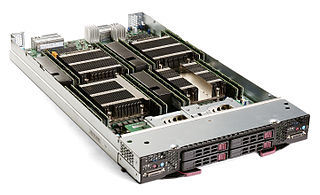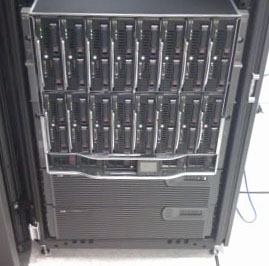
SOAP is a messaging protocol specification for exchanging structured information in the implementation of web services in computer networks. Its purpose is to provide extensibility, neutrality and independence. It uses XML Information Set for its message format, and relies on application layer protocols, most often Hypertext Transfer Protocol (HTTP) or Simple Mail Transfer Protocol (SMTP), for message negotiation and transmission.
The PowerPC 970, PowerPC 970FX, PowerPC 970GX, and PowerPC 970MP are 64-bit PowerPC processors from IBM introduced in 2002. When used in PowerPC-based Macintosh computers, Apple referred to them as the PowerPC G5.
Cell is a multi-core microprocessor microarchitecture that combines a general-purpose PowerPC core of modest performance with streamlined coprocessing elements which greatly accelerate multimedia and vector processing applications, as well as many other forms of dedicated computation.

A blade server is a stripped-down server computer with a modular design optimized to minimize the use of physical space and energy. Blade servers have many components removed to save space, minimize power consumption and other considerations, while still having all the functional components to be considered a computer. Unlike a rack-mount server, a blade server fits inside a blade enclosure, which can hold multiple blade servers, providing services such as power, cooling, networking, various interconnects and management. Together, blades and the blade enclosure form a blade system, which may itself be rack-mounted. Different blade providers have differing principles regarding what to include in the blade itself, and in the blade system as a whole.
The following tables compare general and technical information for a number of relational database management systems. Please see the individual products' articles for further information. Unless otherwise specified in footnotes, comparisons are based on the stable versions without any add-ons, extensions or external programs.
A table is a collection of related data held in a table format within a database. It consists of columns, and rows.

A hardware security module (HSM) is a physical computing device that safeguards and manages digital keys for strong authentication and provides cryptoprocessing. These modules traditionally come in the form of a plug-in card or an external device that attaches directly to a computer or network server.
A media processor, mostly used as an image / video processor, is a microprocessor-based system-on-a-chip which is designed to deal with digital streaming data in real-time rates. These devices can also be considered a class of digital signal processors (DSPs).
A spatial database is a database that is optimized for storing and querying data that represents objects defined in a geometric space. Most spatial databases allow the representation of simple geometric objects such as points, lines and polygons. Some spatial databases handle more complex structures such as 3D objects, topological coverages, linear networks, and TINs. While typical databases have developed to manage various numeric and character types of data, such databases require additional functionality to process spatial data types efficiently, and developers have often added geometry or feature data types. The Open Geospatial Consortium developed the Simple Features specification and sets standards for adding spatial functionality to database systems. The SQL/MM Spatial ISO/IEC standard is a part the SQL/MM multimedia standard and extends the Simple Features standard with data types that support circular interpolations.

The IBM BladeCenter was IBM's blade server architecture, until it was replaced by Flex System. The x86 division was later sold to Lenovo in 2014.

EXPRESS is a standard data modeling language for product data. EXPRESS is formalized in the ISO Standard for the Exchange of Product model STEP, and standardized as ISO 10303-11.
The Rule Interchange Format (RIF) is a W3C Recommendation. RIF is part of the infrastructure for the semantic web, along with (principally) SPARQL, RDF and OWL. Although originally envisioned by many as a "rules layer" for the semantic web, in reality the design of RIF is based on the observation that there are many "rules languages" in existence, and what is needed is to exchange rules between them.

A system on a module (SOM) is a board-level circuit that integrates a system function in a single module. It may integrate digital and analog functions on a single board. A typical application is in the area of embedded systems. Unlike a single-board computer, a SOM serves a special function like a system on a chip (SoC). The device integrated in the SOM typically requires a high level of interconnection for reasons such as speed, timing, bus-width etc., in a highly integrated module. There are benefits in building a SOM, as for SoC; one notable result is to reduce the cost of the base board or the main PCB. Two other major advantages of SOMs are design-reuse and that they can be integrated into many embedded computer applications.
BLADE Network Technologies, based in Santa Clara, California, was a supplier of Ethernet network switches for blade servers and server and storage data center racks. BLADE became part of IBM System Networking in 2010. Later sold to Lenovo as part of purchase of IBM x86 server division

BladeSystem is a line of blade server machines from Hewlett Packard Enterprise that was introduced in October 2004.

IBM zEnterprise System is the latest line of IBM mainframes designed to offer both mainframe and distributed server technologies in an integrated system. The zEnterprise System consists of three components. First is a System z server – a choice of the newest enterprise class server, the IBM zEnterprise EC12 that was announced August 28, 2012, the smaller business class server the IBM zEnterprise 114 (z114) announced July 2011, or the older enterprise-class server the IBM zEnterprise 196 (z196) that was introduced July 2010. Second is the IBM zEnterprise BladeCenter Extension (zBX), the infrastructure designed to provide logical integration and host IBM WebSphere DataPower Integrated Appliance XI50 for zEnterprise or general purpose x86 or Power ISA blades. Last is the management layer, IBM zEnterprise Unified Resource Manager (zManager), which provides a single management view of zEnterprise resources.
Some programming languages provide a built-in (primitive) or library decimal data type to represent non-repeating decimal fractions like 0.3 and -1.17 without rounding, and to do arithmetic on them. Examples are the decimal.Decimal type of Python, and analogous types provided by other languages.

PureSystems is an IBM product line of factory pre-configured components and servers also being referred to as an "Expert Integrated System". The centrepiece of PureSystems is the IBM Flex System Manager in tandem with the so-called "Patterns of Expertise" for the automated configuration and management of PureSystems.
The OS/360 Object File Format is the standard object module file format for the IBM DOS/360, OS/360 and VM/370, Univac VS/9, and Fujitsu BS2000 mainframe operating systems. In the 1990s, the format was given an extension with the XSD-type record for the MVS Operating System to support longer module names in the C Programming Language. This format is still in use by the z/VSE operating system. In contrast, it has been superseded by the GOFF file format on the MVS Operating System and on the z/VM Operating System. Since the MVS and z/VM loaders will still handle this older format, some compilers have chosen to continue to produce this format instead of the newer GOFF format.
Q# is a domain-specific programming language used for expressing quantum algorithms. It was initially released to the public by Microsoft as part of the Quantum Development Kit.









